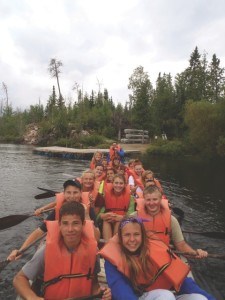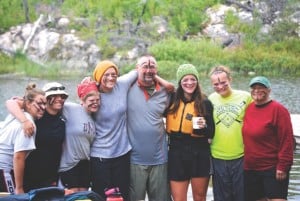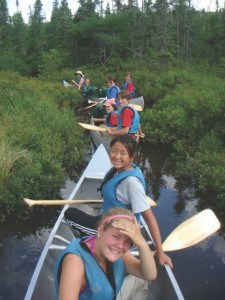By Rob Kesselring

When I have encountered other adults while traveling through the Boundary Waters Canoe Area Wilderness I have sometimes asked them, “Is this your first trip to the BWCA?” Their answers are often the same. “Oh no, I first came here many years ago as a child…I was a camper.” With that disclosure a sparkle brightens their eyes. They might go on and talk about a “Y” camp, scout camp, church camp or a school group, but there is always a recollection of a special moment when they caught the wilderness bug.
The adolescent canoe camp adventure inspires an appreciation for wilderness and a joy for traveling by canoe, and camping out under pine shaded forests and star-studded skies, all the while uninhibited by the trappings of modern civilization. Even more, the challenges of wilderness travel infuse their souls with the values of courage and perseverance. As sticky as balsam sap on their fingers, those early formative experiences pull them back again and again. Ten, twenty, thirty, forty and fifty years later.
Wilderness Canoe Base on Seagull Lake is one such formative canoe camp program with a long, storied, and challenging history. Like many great accomplishments, this camp began as a simple idea by a group of courageous newly ordained Lutheran ministers who believed that institutionalized, troubled, and at-risk youth from urban Minneapolis could experience a spiritual awakening and turn their lives around by paddling the wilds of northern Minnesota under trained, capable, Christian leadership.
Supported and encouraged by their Luther Seminary mentors, their parents, volunteers, local land owners and the trustees of the Plymouth Christian Youth Center (PCYC), The Wilderness Canoe Base was hatched in the early 1950’s and a rustic camp on Seagull Lake was built. On June 18, 1957 a group of boys from the Juvenile Correctional Facility in Redwing, Minnesota were the first of many to benefit from the camp’s wilderness canoe trips that commenced and ended at the base.


In May of 2007, the infamous Ham Lake wild fire burned 75,000 acres of forest on both sides of the Gunflint Trail. Almost one third of the 138 structures destroyed by this massive burn were part of Wilderness Canoe Base. Of the camp’s 60 structures 40 were consumed by flames, including all but three of the historic buildings acquired and moved to the camp in the late 1950’s. Within a year the camp raised over $300,000 to rebuild. This response to adversity demonstrated to the campers, once again, that perseverance can overcome any obstacle. Just as a calm lake mirrors the visage of a paddler, the stalwart and resilient history of this camp reflects back into the character of those brave campers who accept the challenge and the promise of the paddle and the gospel.

There is no better guarantee that the special protections of the Quetico-Superior will be maintained and even enhanced than by the introducing the joys of canoe camping to the youth of America. Environmental causes vying for the attention and support from citizenry will only increase in the decades ahead. What causes will stand out? None will have more pop than commitments forged by campfires. Youth camps on the borders of the Boundary Waters Wilderness and Quetico Parks create lifelong devotion to wilderness camping, kindled by childhood memories. The Wilderness Canoe Base on Seagull Lake is one of the finest.
For more information: http://campwapo.org/camp/wilderness
“One Step at a Time”
By Kate Kincade

“This is a lot steeper than I had imagined,” I thought to myself, staring up at the rocky hill in front of me. After a glance towards the rest of my group, who were floating in the canoes beside me, it was clear that they were all as nervous as I was.
It was our fourth day on trail, and we stood at the landing of the Paulson Lake Portage. Despite our days of practice, I found myself feeling unprepared for the treacherous climb ahead. As a clumsy 13-year-old, it seemed as though I could hardly walk in a straight line without tripping over my own feet, let alone climb a hill with a canoe on my back.
Pushing the doubt to the back of my mind, I started towards the bottom of the portage. One step at a time, I thought. With a wave of determination, our group pushed forward. We all made it to the top of the hill unscathed. Standing at the top of the portage, we could see Paulson Lake behind us, and ahead was Seagull Lake, the location of our home camp, Wilderness Canoe Base.
Where I see God in the wilderness is not neces- sarily in the rigor of portaging, but in the quiet that follows. There is something to be said about the peace found in silent paddles, glassy lakes and fearless dragonflies that zip quietly across the surface of the water. This is what I have learned in my five years as a camper and swamper at Wilderness Canoe Base.
Canoeing and wilderness will always be a part of my life and I plan on returning to the Bound- ary Waters for many years to come.
Read more in the Spring 2014 issue of Wilderness News

